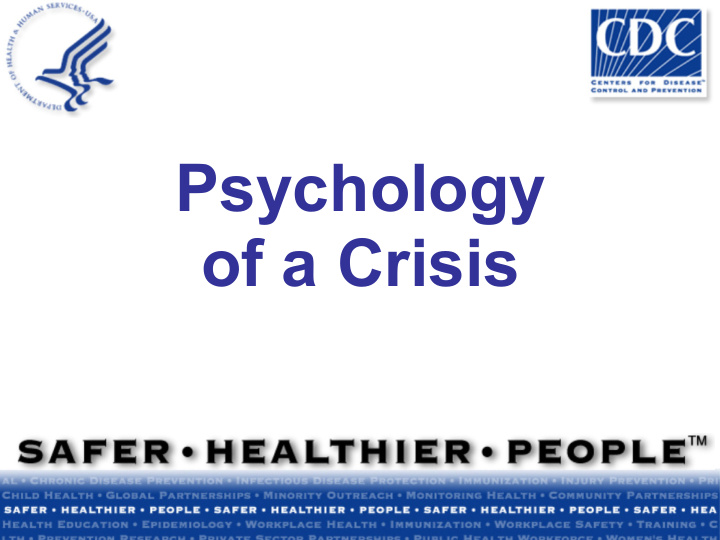



Psychology of a Crisis
Module Summary • Common negative feelings and behaviors for people during a crisis • How communication differs in a crisis • Risk communication principles for emergencies
Psychology of a Crisis Common human emotions— left without mitigating response— may lead to negative behaviors that hamper recovery or cause more harm.
Negative Behaviors • Demands for unneeded treatment • Reliance on special relationships • Unreasonable trade and travel restrictions • MUPS—Multiple Unexplained Physical Symptoms
What Do People Feel Inside When a Disaster Occurs or Looms? • Denial • Fear and avoidance • Hopelessness or helplessness • Vicarious rehearsal • Seldom panic
What Is Vicarious Rehearsal? • The communication age gives national audiences the experience of local crises. These armchair victims mentally rehearse recommended courses of actions. • Recommendations are easier to reject the farther removed the audience is from real threat. • The worried well can heavily tax response and recovery.
What’s Different During a Crisis?
Communicating in a Crisis Is Different When in “fight or flight” moments of an emergency, more information leads to decreased anxiety.
Decisionmaking in a Crisis Is Different • People simplify • Cling to current beliefs • We remember what we see or previously experience (first messages carry more weight)
So How Do We Initially Communicate in a Crisis? S imply T imely A ccurately R epeatedly C redibly C onsistently
How Do We Communicate About Risk in an Emergency? All risks are not accepted equally • Voluntary vs. involuntary • Controlled personally vs. controlled by others • Familiar vs. exotic • Natural vs. manmade • Reversible vs. permanent • Statistical vs. anecdotal • Fairly vs. unfairly distributed • Affecting children vs. affecting adults
Be Careful With Risk Comparisons • Are they similarly accepted based on – high/low hazard – high/low outrage A. High hazard B. High outrage C. Low hazard D. Low outrage • Give examples • Cornerstone of risk acceptance
Risk Acceptance Examples • Dying by falling coconut or dying by shark – Natural vs. manmade – Fairly vs. unfairly distributed – Familiar vs. exotic – Controlled by self vs. outside control of self
Risk Communication Principles for Emergencies Don’t overreassure • Considered controversial by some. • A high estimate of harm modified downward is much more acceptable to the public than a low estimate of harm modified upward.
Risk Communication Principles for Emergencies State continued concern before stating reassuring updates “Although we’re not out of the woods yet, we have seen a declining number of cases each day this week.”
Risk Communication Principles for Emergencies Confidence vs. uncertainty Instead of making promises about outcomes, express the uncertainty of the situation and a confident belief in the “process” to fix the problem and address public safety concerns.
Risk Communication Principles for Emergencies Give people things to do - Anxiety is reduced by action and a restored sense of control • Symbolic behaviors (e.g., going to a candlelight vigil) • Preparatory behaviors (e.g., buying water and batteries) • Contingent “if, then” behaviors (e.g., creating an emergency family communication plan)
Risk Communication Principles for Emergencies Give people things to do - Anxiety is reduced by action and a restored sense of control • Single most important action for self-protection • Recommend a 3-part action plan • You must do X • You should do Y • You can do Z
Risk Communication Principles for Emergencies Allow people the right to feel fear • Don’t pretend they’re not afraid, and don’t tell them they shouldn’t be. • Acknowledge the fear, and give contextual information.
Recommend
More recommend